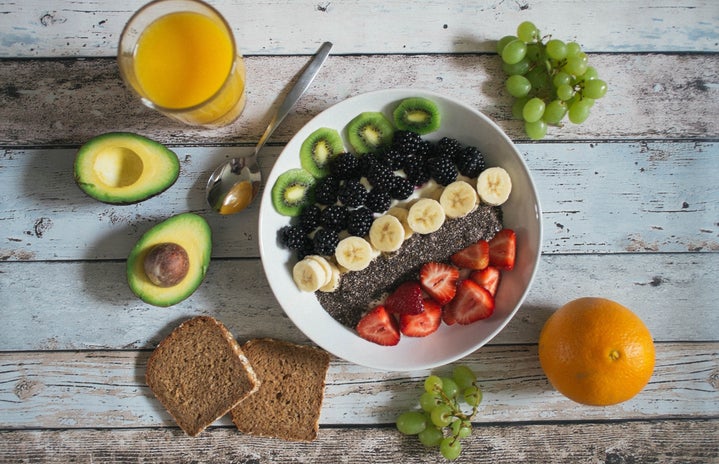I’ve been wanting to become a full-fledged vegan since I first heard about the lifestyle in high school. I tried a couple times to be vegetarian or simply to eat incredibly healthy, but nothing ever quite stuck. In my freshman year of college, I had the worst diet of my life (they don’t call it Freshman Fifteen for nothing) and lived on cereal, muffins and mac n cheese for weeks.
Of course, I felt awful eating that way but didn’t quite understand that becoming healthy isn’t about diving in—it’s about wading into the waters. Now in my second year living on my own, I understand that. For the past several months, I’ve waded deeper in and am so proud of the progress I’ve made. Although I’m not quite where I want to be yet, I know my plan and I feel like I can stick to it.
Many of us dramatically change our lifestyles once we are living on our own with the ability to make our own choices and set our own paths. For those who, like me, are looking for huge dietary changes, here are some tips on transitioning into veganism one baby step at a time.
1. Build a support network, but swim alone
Gif courtesy The Friendly Fig
My family is carnivorous, to say the least. Not only do they not understand veganism, vegetarianism or being gluten-free (many of them think it’s all about weight loss, not inner health or animal care), but they do not indulge in it. I had been slowly cycling meats out of my daily diet for a couple months when the holidays rolled around. You know what that means—turkey. I decided to let Thanksgiving be my last hoorah before saying goodbye to poultry for good, and let my family know that I would no longer be eating meat (since I reckoned I wouldn’t be at my final stage of veganism by Christmas).
Of course, you can’t let their opinions, jokes or snide comments deter you. You’re not asking for permission, you’re providing courtesy information; this isn’t a discussion, either, unless they’re generally interested. In my experience, family is the hardest part in adapting lifestyle changes because it is the lifestyle you are changing away from. Do not fret, though. After preparing a few vegan / vegetarian dishes for them during the holidays and sneakily feeding them tofurkey, they’ll get used to the new normal.
Although this is a journey you’re taking for yourself and by yourself, the closest people in your life to you—be it a significant other or best friends—should support, encourage and keep you on track. For me, it’s my best friend and soon-to-be roommate who indulges in my vegan-fanaticism, and is even willing to dabble in the lifestyle. Though these friends may teasingly waft some ice cream or chocolate chip cookies under your nose from time to time, they’re more than willing to try that trendy vegan diner down the street with you, too.
Lastly, social media is a fantastic (optional) tool for you to keep yourself on track and join a community who are either deep into or, like you, first-timers for a dietary lifestyle. I personally use my social media to encourage myself to keep eating healthy by posting photos of my vegetarian / vegan meals on Insta Stories. It may sound lame, but it does the trick for me.
2. Identify your strengths and weaknesses
Gif courtesy Zumto
First thing’s first when it comes to cycling out the meat and dairy products from your lifestyle. For myself, I started with the food group I could most easily live without (a.k.a my strengths): red meat. When living on my own, I don’t ever buy red meat. However, I knew that when I go out or when I went home I often had pot roast, hamburgers or steak, but I never craved any of these so they were the easiest to let go of. Then, I got rid of as much gluten and junk foods as possible. I already had been living on a partial gluten free diet due to my father’s allergy, so I just made a conscious effort to pick up vegetable-based or gluten free pasta and breads when I went to the grocery store. However, being gluten free is not as important to me, so I do still tend to allow myself some gluten-filled treats such as cereals or muffins.
Currently, I’m working on eliminating poultry from my diet, which is definitely the hardest thing thus far (a.k.a my weakness) since I pretty much ate chicken with every lunch or dinner meal. I’ve successfully stopped buying actual chicken from the store and cooking it for meals, but I do absentmindedly buy some frozen or canned/boxed meals that have bits of chicken in them. Just this week I bought a bag of frozen chicken stir fry and a can of chicken noodle soup without realizing. So, I’ve identified my weakness—chicken—and now I come up with a solution. Since the only chicken I’ve been eating is in pre-made meals, I know I should start cooking things from scratch, something I do not tend to do due to my hectic work and class schedule. All the same, I can (and will) make an effort to meal prep all my dinners on Sunday after I grocery shop so I don’t need to resort to pre-made chicken-included meals.
Although I haven’t made it past chicken yet, my final step will be to eliminate dairy products, including milk and cheese. This will most definitely be the hardest part for me since I love dairy products. My plan is to try some unsweetened almond milk next week and later work on finding some good vegan cheese and ice cream.
3. Substitution and addition
Gif courtesy Giphy
You’ve read a lot of the word “eliminate,” to the point that it seems I won’t be eating anything at all. Not the cast, though. With each “elimination,” I’m first trying vegan versions of the product until I find some that I genuinely like just as much, if not more than, the original. For example, I absolutely love and prefer Gardein’s meatless meatballs, which I’ll cook and put on top of some gluten free pasta for dinner. Or, Gardein’s groundless “beef” which I’ll mix with vegetables and eat in tacos. It’s all about finding the right brands of food that you love that can replace your unhealthy go-tos.
Don’t forget about additions, though. With a plant-based diet, you lose a lot of your daily intake of protein. Personally, I know I don’t eat enough fruit or, especially, vegetables every day. I’m working on ways to implement those three things into my daily diet in a yummy, healthy way, too.
4. Make grocery shopping a self-care ritual
Gif courtesy Tenor
I used to hate grocery shopping. Living in the city, it becomes a hassle having to lug your grocery bags a few blocks to the store, then root around for all your products until you’re practically sweating, then bagging and lugging all of your multiple reusable grocery bags back multiple blocks to your apartment building (sometimes in the rain, snow, ice or wind) and by that time you’re definitely sweating. Last year, I avoided grocery shopping as much as possible and only went every couple weeks, at which point I’d buy as much boxed and canned items as I could to see if I could go a whole month without going grocery shopping again. Now, I’ve made a conscious effort to change that.
Every week, I set aside two or three hours, usually on Sunday or Thursday morning when I’m not busy with work or school, to put on some cozy clothes, take a meandering walk to the store and listen to music or call a friend to talk while I slowly and calmly grocery shop, picking out a few new items that I’m excited to try every week. This week, my new items were frozen acai bowls and butternut squash risotto. Then, I lug all my things back home and organize my kitchen, a task I love. Making grocery shopping a self-care ritual by adding small things you actually enjoy will make eating healthy that much easier. You can’t eat junk if you don’t buy junk, and you won’t buy junk if you’re in a good mood at the store. That’s my philosophy.
5. Just keep swimming
Gif courtesy Giphy
Transitioning into a new dietary lifestyle isn’t a single-destination journey, it’s for forever, whether it be veganism, vegetarianism, paleo, raw or whatever else there is. You have to keep identifying what you’d like to change, finding a realistic and enjoyable solution, and then implementing that solution at a steady pace that is right for YOU. For me, I know that as I work toward fully adapting myself to the vegan lifestyle, I also want to work on adding a regular fitness schedule to my life, and I plan to do so using the same wading method I’ve used thus far in my food journey—by beginning with daily morning yoga, fixing my weakness of skipping workouts because I’m tired, and finding additions to my fitness journey, such as pilates, spinning and kickboxing. It’s the “wade” method—works every time.



